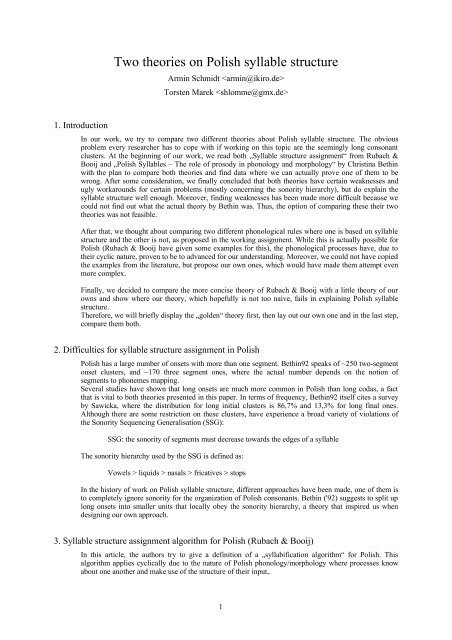You also want an ePaper? Increase the reach of your titles
YUMPU automatically turns print PDFs into web optimized ePapers that Google loves.
Two theories on <strong>Polish</strong> <strong>syllable</strong> <strong>structure</strong>Armin Schmidt Torsten Marek 1. IntroductionIn our work, we try to compare two different theories about <strong>Polish</strong> <strong>syllable</strong> <strong>structure</strong>. The obviousproblem every researcher has to cope with if working on this topic are the seemingly long consonantclusters. At the beginning of our work, we read both „Syllable <strong>structure</strong> assignment“ from Rubach &Booij and „<strong>Polish</strong> Syllables – The role of prosody in phonology and morphology“ by Christina Bethinwith the plan to compare both theories and find data where we can actually prove one of them to bewrong. After some consideration, we finally concluded that both theories have certain weaknesses andugly workarounds for certain problems (mostly concerning the sonority hierarchy), but do explain the<strong>syllable</strong> <strong>structure</strong> well enough. Moreover, finding weaknesses has been made more difficult because wecould not find out what the actual theory by Bethin was. Thus, the option of comparing these their twotheories was not feasible.After that, we thought about comparing two different phonological rules where one is based on <strong>syllable</strong><strong>structure</strong> and the other is not, as proposed in the working assignment. While this is actually possible for<strong>Polish</strong> (Rubach & Booij have given some examples for this), the phonological processes have, due totheir cyclic nature, proven to be to advanced for our understanding. Moreover, we could not have copiedthe examples from the literature, but propose our own ones, which would have made them attempt evenmore complex.Finally, we decided to compare the more concise theory of Rubach & Booij with a little theory of ourowns and show where our theory, which hopefully is not too naive, fails in explaining <strong>Polish</strong> <strong>syllable</strong><strong>structure</strong>.Therefore, we will briefly display the „golden“ theory first, then lay out our own one and in the last step,compare them both.2. Difficulties for <strong>syllable</strong> <strong>structure</strong> assignment in <strong>Polish</strong><strong>Polish</strong> has a large number of onsets with more than one segment. Bethin92 speaks of ~250 two-segmentonset clusters, and ~170 three segment ones, where the actual number depends on the notion ofsegments to phonemes mapping.Several studies have shown that long onsets are much more common in <strong>Polish</strong> than long codas, a factthat is vital to both theories presented in this paper. In terms of frequency, Bethin92 itself cites a surveyby Sawicka, where the distribution for long initial clusters is 86,7% and 13,3% for long final ones.Although there are some restriction on these clusters, have experience a broad variety of violations ofthe Sonority Sequencing Generalisation (SSG):SSG: the sonority of segments must decrease towards the edges of a <strong>syllable</strong>The sonority hierarchy used by the SSG is defined as:Vowels > liquids > nasals > fricatives > stopsIn the history of work on <strong>Polish</strong> <strong>syllable</strong> <strong>structure</strong>, different approaches have been made, one of them isto completely ignore sonority for the organization of <strong>Polish</strong> consonants. Bethin ('92) suggests to split uplong onsets into smaller units that locally obey the sonority hierarchy, a theory that inspired us whendesigning our own approach.3. Syllable <strong>structure</strong> assignment algorithm for <strong>Polish</strong> (Rubach & Booij)In this article, the authors try to give a definition of a „syllabification algorithm“ for <strong>Polish</strong>. Thisalgorithm applies cyclically due to the nature of <strong>Polish</strong> phonology/morphology where processes knowabout one another and make use of the <strong>structure</strong> of their input,.1
The algorithmIn order not to drop the SSG for <strong>Polish</strong> completely, the authors state the „the consonant at an edge of aword ... does not count from the point of view of the SSG“, which has been proposed several timesbefore and takes care of a large number of otherwise invalid constructions. The reanalysis of allquestionable words with the work hypothesis also leads to the result most of the SSG violations are nowwrong orders among obstruents. This suggests that it is desirable to merge fricatives and stops into onesonority class of obstruents.Before working on the algorithm, the authors give a couple of more general rules:- Obstruent Sequencing Constraint (OSC)Geminate sequences are always split between two <strong>syllable</strong>s (VC 1C 1V is always syllabified as VC 1-C 1V), otherwise there is no need of sonority distance between two distinct consonants from the samesonority class- Coda constraint (CC)The coda may not contain two sonorants- High vowel constraint (HWC)If [i] occurs before [u], it does not receive an N slot and therefore is changed into a glideThe rules of syllabification will know be specified. All of them have to satisfy the SSG, the OSC, the CCand the HWC as well (all drawings taken from Rubach & Booij (1990)):1Name Obligatory Description PictureN-Placement yes For every nonconsonantalsound atthe melody tier, an N isplaced at the <strong>syllable</strong>tier2Progressive gliding yes If [i] or u occur after avowel, their slot doesnot receive an N butthey are changed intothe glides [j] or [w]3CV-Rule yes If there is something tothe left of an N, it isincluded into the onset.In any case, a N” nodeis created.4<strong>Polish</strong> onset no Put another consonantinto the onset (mayapply several times)5<strong>Polish</strong> coda no Insert a consonantfrom the right into thecoda2
Complex coda no Insert one moreconsonant from theright into the coda6These rules lead to sequences of VCV always being syllabified as V-CV, while for VCCV, V-CCV(Rules: N-Placement – CV Rule – <strong>Polish</strong> onset) or VC-CV (Rules: N-Placement – CV Rule – <strong>Polish</strong>coda) are equally possible. To cope with this kind of ambiguity, the authors have conducted field studywith <strong>Polish</strong> native speakers. Their results suggest that longer onsets are preferred over long codas,justifying the order of the formalisms.Application, reapplication and restructuring:Since we are not interested in the cyclic <strong>structure</strong> of <strong>Polish</strong> phonology here, we just subsume the furtherfindings of the authors, stating that their syllabification algorithm itself is cyclic and is reapplied to theprosodic word <strong>structure</strong> after every phonological rule. Furthermore, they say that the codas from the lastrun of the algorithm are erased at the beginning of a new algorithm application. Since this, too, has to dowith cyclic phonology, we simply ignore it for the sake of brevity and only work with theirsyllabification rules.4. The Semi-Syllable Approach (Marek&Schmidt)Our hypothesis presumes some of the major constraints in <strong>Polish</strong> phonology that have already beenstated introducing Rubach and Booij's model and which seem to be consensus among phonologistsworking on <strong>Polish</strong> <strong>syllable</strong> <strong>structure</strong>. These are specifically: the Sonority Sequencing Generalization(SSG), the Obstruent Sequencing Constraint (OSC), and the High Vowel Constraint (HWC).Furthermore, we assume that every vowel functions as a nucleus and thus agree on N-placement as afirst step in the syllabification process. In addition, we accept the finding of Rubach & Booij that longonsets are preferred over long codas, which will prove to be quite central in our model.As for the sonority hierarchy used, we will actually include glides and distinguish between fricatives andstops, thus arriving at the following sonority scale:vowels > glides > liquids > nasals > fricatives > stopsThe basic or "core” <strong>syllable</strong> we assume to be CV that can be extended to CVC. In addition, we willintroduce a <strong>syllable</strong> missing a vowel and thus having no nucleus, a concept that shall be called semi<strong>syllable</strong>($) in the ongoing discussion.The idea here is to try to show that SSG does apply in <strong>Polish</strong> and can be retained even in the case ofconsonant clusters that appear to violate it heavily from the first sight. These consonant clusters whichmost of the times occur word initially can, as is to be seen, be split into smaller units that do confirm theSSG. These semi-<strong>syllable</strong>s consist of only consonants whereas, due to the lack of a vowel, one of theconsonants takes the nucleus role. In a final step, they are concatenated with the onset of the following"full" <strong>syllable</strong> in an iterative manner.The algorithm executed on the example krtań is as follows:Step Description Picture1N-placement: for every non-consonantal sound at the melodytier, a N is placed at the <strong>syllable</strong> tierN|V|k r t a ń3
2Take as much of the consonants on the left of the V and putthem into the onset as long as they are in rising sonority (SSG)and do the same for the coda and elements on the right of thenucleus:O N C| | |C V C| | |k r t a ń3Semi-syllabify the remaining consonants into as many semi<strong>syllable</strong>sas needed. In our example it’s only one$ σC C O N C| | | | |k r t a ń4The word krtań is syllabified into only one <strong>syllable</strong> by <strong>Polish</strong>speakers, so our suggestion is that in <strong>Polish</strong>, all full <strong>syllable</strong>sneed at least one vowel, semi-<strong>syllable</strong>s merge into the onset ofthe next full <strong>syllable</strong>OσN C| |k r t a ń5. Comparison Syllable Structure Algorithm (SSA) by Rubach&Booij vs. Semi-SyllableApproach (SM) by Marek&SchmidtThe SSA as well as the SM both explain most of the complications concerning the retainment of theSSG in <strong>Polish</strong> well enough.The SSA does, to our knowledge, actually approach all cases and suggests solutions for them, but it isalso found that it exhibits certain difficulties explaining, for example (a) initial obstruent-liquidobstruentclusters and (b) splits of consonant clusters in multisyllabic words. These problems are dealtwith in a rather unsatisfying manner, introducing complicated extra-rules with an unclear base: for (a)the iteratively applying <strong>Polish</strong> Onsets Rule, and for (b) the observation that onsets are preferred overcodas. In terms of predictability, these struggle with many cases where several alternatives are possible.Nevertheless, the algorithm provides solutions for (almost?) all cases.The SM leads to an algorithm that is a lot simpler and does not introduce any extra rules. Moreover, itexplains how the problem of seeming violation of the SSG can be dealt with in a theory-based approach.However, there are two major weaknesses with SM. For one, the algorithm heavily overgenerates.According to Bethin ('92), it is not arbitrary what consonants do appear in <strong>Polish</strong> consonant clusters. Onthe opposite, field study shows that certain sequences prove to occur very often, whereas others appearto be disallowed totally with an occurrence rate of zero. The SM algorithm, however, would allow, intheory, any consonant sequence in a semi-<strong>syllable</strong> as long as it is not ruled out by the OSC. In terms ofpredictability, SM would not help a lot.Furthermore, there is a large set of consonant clusters that seemingly violate the SSG and occur wordfinally. These naturally cannot be merged into a following onset (there is none) and would thus bedisallowed according to SM. This happens even in quite short and very frequent clusters consisting of anobstruent-sonorant sequence, for example in teatr 'theatre' (stop followed by liquid). This single point offailure suggests the discard of the algorithm or at least some extension, which cannot be provided here.4
6. ConclusionAccounting the analysis of the two different models given above, we find that our own model does notsuffice in a great number of cases, which Rubach and Booij's SSA actually can handle, although in aquite unaesthetical manner. Still we understand that trying syllabification on sample data with bothalgorithms clearly speaks in favour of Rubach&Booij.Literature1Bethin, Christina Y.. <strong>Polish</strong> Syllables: The Role of Prosody in Phonology and Morphology. Publisher:Slavica. Place of Publication: Columbus, Year of Publication: 1992.2Rubach, Jerzy. Booij, Geert. Syllable Structure Assignment in <strong>Polish</strong>. Phonology. 7 (1): 121-158.1990.5




